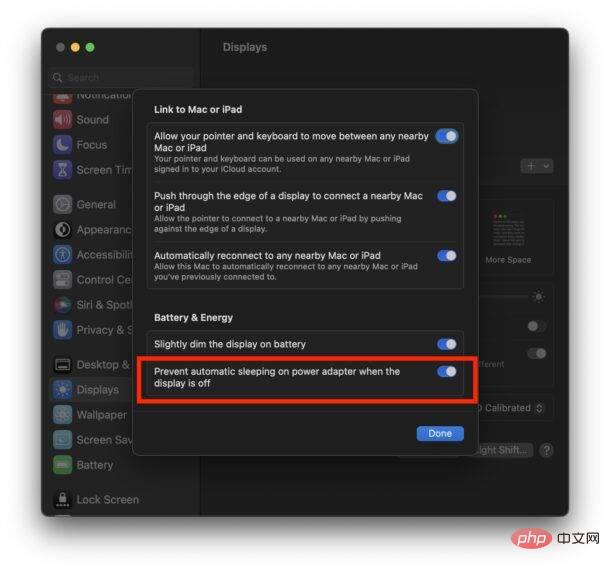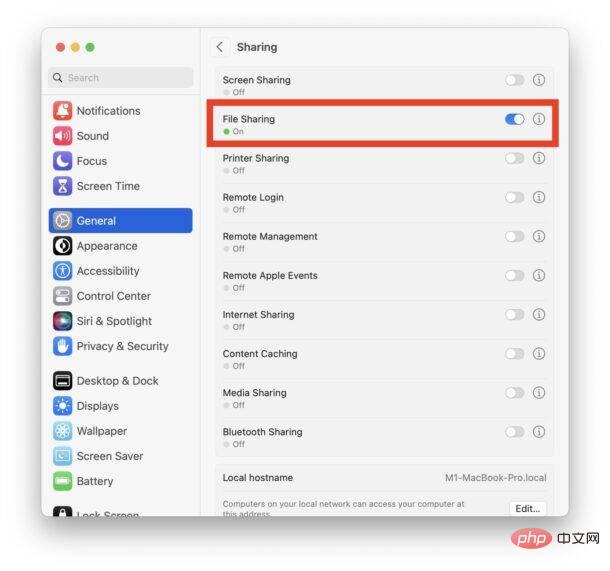php editor Baicao will introduce you to the shortcut key addresses in the mac system to help you locate and operate more efficiently. When using a Mac system, shortcut keys are a powerful tool to improve work efficiency. Learning to use shortcut keys can save a lot of time and energy. This article will summarize the commonly used mac system shortcut key addresses for everyone, so that you can easily master shortcut key skills and improve work efficiency. Whether for daily use or professional work, these shortcut keys will have a positive impact on your Mac experience. Let’s take a look below!
What are the mac keyboard shortcuts
1. Option–Command–power button* or Option–Command–Media Eject (Option–Command–media eject key): Put your Mac in sleep state.
2. Mac shortcut key for back one step: in the browser: (command) / is to go forward or backward, (command) ↑/↓ is to scroll to the top or bottom. In Finder: (command) ↑/↓ is to go up a level or enter a folder.
In Mac, there are four main modifier keys: Command, Control, Option, and Shift. They often appear in the menu bar of Mac applications and have their own patterns. The existence of these keys makes it easier to learn new shortcut keys and master them at any time.
4. Apple computers, also known as Mac computers, are usually operated using a keyboard and mouse (or trackpad).

Mac system shortcut keys collection
- Apple computers have many useful system shortcut keys, such as Command C (copy), Command V (paste), Command Z (Undo) etc. You can find tips for these shortcuts in the application's menu bar.
There are four main modifier keys in Mac: Command, Control, Option, and Shift. They are displayed with unique patterns in the menu bar of Mac applications, making it easier for users to learn new shortcut keys at any time.
Mac back step shortcut key: In the browser: (command) / is to go forward or backward, (command) ↑/↓ is to scroll to the top or bottom. In Finder: (command) ↑/↓ is to go up a level or enter a folder.
Basic shortcut keys Command is the most important modifier key in Mac, which is equivalent to Ctrl in Windows in most cases.
Ctrl Shift ESC is the shortcut key for opening the Task Manager. This key combination works on both XP and Windows 7 systems. Press and hold these three keys to directly bring up the Task Manager.
mac shortcut keys
1. Power button or Touch ID sensor: Press to turn on your Mac or wake it from sleep. When your Mac is awake, pressing and holding this button for 5 seconds will put your Mac to sleep. Continuing to hold down will force your Mac to shut down.
2. Mac shortcut keys include Command-Z, Command-X, Command-C, Command-V, Command-A, Command-S, Command-F, Command-Shift-Command-Shift-Command- Shift-Control-Command-Shift-Command-Shift-Control-4, etc. Command-Z: Undo.
3. Basic shortcut keys, Command-Z to undo, Command-X to cut, Command-C to copy (Copy), Command-V to paste, Command-A to select all (All), Command-S to save. (Save), Command-F Find (Find).
4. Apple computers, also known as Mac computers, are usually operated using a keyboard and mouse (or trackpad).
5. Many users who are accustomed to Windows operating habits will find it very difficult to use Mac when they get started. In fact, as long as you understand the shortcut keys of the Mac system, you can quickly improve operating efficiency. Today we will take a look at the commonly used shortcut keys on Mac systems and their uses.
What are the shortcut keys for mac system?
MAC shortcut keys include Command Tab, Command F, Command E, Shift Command I, and Command H. Command Tab: It is one of the shortcut keys on Apple Mac, which can quickly switch applications. Press Shift Command Tab simultaneously to show or hide the Fonts window.
Basic shortcut keys, Command-Z to undo, Command-X to cut, Command-C to copy (Copy), Command-V to paste, Command-A to select all (All), Command-S to save (Save) ), Command-F Find.
Control–Command–Power Button*: Forces your Mac to restart without being prompted to save any open and unsaved documents. Control–Command–Media Eject: Exit all apps, then restart your Mac.
Commonly used keys in Mac are Command, Control, Option and Shift.
Using shortcut keys on Mac computers can significantly improve your work efficiency.
Today we will take a look at the commonly used shortcut keys on Mac systems and their uses. Hope it will be helpful to everyone! There are four main modifier keys in Mac, namely Command, Control, Option and Shift.
Mac Keyboard Shortcuts
1. Control-Power button* or Control-Media Eject (Control-Media Eject key): Display a dialog box asking you whether you want to restart or sleep Or shut down.
2. Basic shortcut keys, Command-Z to undo, Command-X to cut, Command-C to copy (Copy), Command-V to paste, Command-A to select all (All), Command-S to save. (Save), Command-F Find (Find).
3. Apple computers, also known as Mac computers, are usually operated using a keyboard and mouse (or trackpad).
How to set shortcut keys on Apple computers
First we open our MAC computer, click on the Apple icon in the upper left corner, and in the drop-down window we click "System Preferences". Then click on the "Keyboard" option in the window that opens. Enter the keyboard window and click on the "Shortcut Keys" bar at the top. Then we click on the "+" icon in the column.
Click the Apple icon in the upper left corner and select System Preferences. In the pop-up window, click Keyboard. On the keyboard settings page, select Shortcut Keys and find the screenshot shortcut key. Click on the right to add a new screenshot shortcut key.
The details are as follows: First, please find the [WeChat] icon on your mobile phone and click to enter the main interface. Step 2: Next, please select the [three] icon button at the bottom left of the screen. In the third step, please select the "Settings" item pointed by the arrow.
Open System Preferences. Click on the keyboard icon, then click on the Shortcuts tab. Click the spotlight on the left. See a spotlight search displayed on the right side. Click on the shortcut keys section at the back, and then press the copy and paste shortcut keys on the keyboard.
Conclusion: The above is all the content about the shortcut key address on mac that this website has compiled for you. Thank you for taking the time to read the content of this website. I hope it will be helpful to you. Don’t forget more related content. Find it on this site.
The above is the detailed content of How to use mac shortcut key address (mac positioning shortcut key). For more information, please follow other related articles on the PHP Chinese website!
 ip与mac绑定什么意思Mar 09, 2023 pm 04:44 PM
ip与mac绑定什么意思Mar 09, 2023 pm 04:44 PMip与mac绑定是指将特定的IP地址与特定的MAC地址关联起来,使得只有使用该MAC地址的设备才能够使用该IP地址进行网络通信。ip与mac绑定可以防止被绑定的主机的IP地址不被假冒,前提条件:1、MAC地址是唯一的,并且不可假冒;只能绑定与路由器直接相连的网络上的主机(也就是主机的网关在路由器上)。
 mac版下载是什么意思Mar 06, 2023 am 09:52 AM
mac版下载是什么意思Mar 06, 2023 am 09:52 AMmac版下载的意思是当软件在选择安装时,选择MAC版下载;Windows版和MAC版是两个不同的操作系统,所以大多数软件在选择安装的同时需要选择Windows版还是MAC版。
 mac鼠标滚轮相反怎么办Mar 16, 2023 pm 05:44 PM
mac鼠标滚轮相反怎么办Mar 16, 2023 pm 05:44 PMmac鼠标滚轮相反的解决办法:1、打开mac电脑,点击屏幕的苹果标志,然后选择“系统偏好设置”;2、在“系统偏好设置”窗口中,选择“鼠标”;3、在“鼠标”窗口中,将“滚动方向:自然”前面的勾去掉即可。
 如何防止 Mac 在显示器关闭时进入睡眠状态 (MacOS Ventura)Apr 13, 2023 pm 12:31 PM
如何防止 Mac 在显示器关闭时进入睡眠状态 (MacOS Ventura)Apr 13, 2023 pm 12:31 PM显示器关闭时如何防止 Mac 休眠如果您希望 Mac 显示器能够在整个计算机不进入睡眠状态的情况下关闭,请在此处进行适当的设置调整:下拉 Apple 菜单并转到“系统设置”转到“显示”点击“高级...”切换“防止显示器关闭时电源适配器自动休眠”的开关现在 Mac 显示屏可以关闭,同时防止 Mac 本身进入睡眠状态。这可能主要与 Mac 笔记本电脑用户相关,但即使是那些没有 MacBook 的用户也可能会发现该功能很有用。
 修复文件共享在 MacOS Ventura 中不起作用Apr 13, 2023 am 11:34 AM
修复文件共享在 MacOS Ventura 中不起作用Apr 13, 2023 am 11:34 AM修复 SMB 文件共享在 MacOS Ventura 中不起作用的问题从 Apple 菜单打开 Mac 上的“系统设置”应用程序转到“常规”,然后转到“共享”找到“文件共享”的开关并将其关闭通过转到 Apple 菜单并选择重新启动来重新启动 Mac重新启动后,返回共享系统设置面板并将“文件共享”重新设置为打开位置像往常一样恢复文件共享,它应该按预期工作如果 MacOS Ventura Mac 与另一台 Mac 或设备之间的文件共享突然再次停止工作,您可能需要在几天后或随机重复此过程。
 mac的shift键是哪个键Mar 13, 2023 pm 02:20 PM
mac的shift键是哪个键Mar 13, 2023 pm 02:20 PMmac的shift键是fn键上方、caps lock键下方的一个键,该键在键盘最左侧,由右下往上数第2个键;shift键是键盘中的上档转换键,可以通过“Ctrl+Shift”组合键来切换输入法。
 mac解压rar用什么软件Mar 03, 2023 pm 04:18 PM
mac解压rar用什么软件Mar 03, 2023 pm 04:18 PMmac解压rar的软件:1、The Unarchiver,是一款完全免费、小巧,而且非常易于使用的压缩、解压缩小工具;2、Keka,是一款免费、实用的压缩、解压缩工具,支持解压缩RAR格式的压缩包;3、360压缩大师,是一款免费的压缩、解压缩软件,完全支持RAR文件解压;4、MacZip,支持包括RAR在内的超过20种压缩格式的解压;5、BetterZip;6、FastZip。
 mac克隆是什么意思Jan 31, 2023 am 10:33 AM
mac克隆是什么意思Jan 31, 2023 am 10:33 AMmac克隆全称mac地址克隆,是固化在网卡上串行EEPROM中的物理地址,通常有48位长。mac克隆一般应用在路由器上,用户在用电脑直接拨号上网,后来又加了个路由器,通过路由器来实现多台电脑同时上网,这时要用到mac地址克隆了,就是把当前的电脑的mac地址克隆到路由器中去,因为运营商是把你的电脑mac地址绑定你的账号的,所以得克隆以后才能用。


Hot AI Tools

Undresser.AI Undress
AI-powered app for creating realistic nude photos

AI Clothes Remover
Online AI tool for removing clothes from photos.

Undress AI Tool
Undress images for free

Clothoff.io
AI clothes remover

AI Hentai Generator
Generate AI Hentai for free.

Hot Article

Hot Tools

EditPlus Chinese cracked version
Small size, syntax highlighting, does not support code prompt function

MinGW - Minimalist GNU for Windows
This project is in the process of being migrated to osdn.net/projects/mingw, you can continue to follow us there. MinGW: A native Windows port of the GNU Compiler Collection (GCC), freely distributable import libraries and header files for building native Windows applications; includes extensions to the MSVC runtime to support C99 functionality. All MinGW software can run on 64-bit Windows platforms.

SublimeText3 Chinese version
Chinese version, very easy to use

PhpStorm Mac version
The latest (2018.2.1) professional PHP integrated development tool

SublimeText3 Linux new version
SublimeText3 Linux latest version






